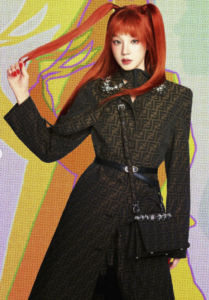GRAPHIC DESIGN Lydia Charron
Listen. Fashion is a waste monster.
“The climate crisis wave has hit fashion, and the industry is responding.”
This is something we already know, we’ve known for a while, and finally, the designers and companies have come to realize we’ve figured it out. With the world quite literally burning and drowning simultaneously, the industry’s priorities are getting ‘vibe checked.’ Sustainability is not only a word, but an ideology that has taken over the fashion world. Young women like Greta Thunberg and Autumn Peltier are igniting an international conflict between the way we live and the way we ought to. The climate crisis wave has hit fashion, and the industry is responding.
The concept of sustainability simply means “meeting our own needs without compromising the ability of future generations.” The dialogue of sustainability within fashion has been critical on producer’s waste, and water consumption. EDGEExpo has a quick article about fashion waste facts, sporting findings such as fashion being the second leading pollutant in the world. Fashion causes up to 20% of global water waste; for example, processing cotton takes up to 20,000L of water per pair of denim.
Heritage houses have abandoned fur; Gucci, Michael Kors and, Versace doing so in 2018, Prada announcing to do so by February 2020. Fashion has made its first attempt at adapting their textiles, techniques, and talents toward sustainable ways of making clothes. From haute couture to high street producers, creators are being asked to take up some ecological responsibility. Not only have designers responded with attempts such as using sensible materials, as well as recognizing waste and water consumption, but brands have formed under the identity of making enduring, symbiotic, affordable clothing. Basics brands like Organic Basics, reselling e-platforms, and stores like Depop, Grailed, or Reformation are all gaining traction. Through reselling, recycling, and up-cycling, clothes are kept in closets and out of landfills.
These brands are bringing with them new policies of transparency. Factories provide millions of jobs for millions of people. However, there is an extensive history and knowledge of factory work being grueling and treacherous for minimal pay in dangerous environments. Although waste management and ecological responsibility dominate fashion’s discussion surrounding sustainability, the conversation becomes bigger than that.
In a conversation at the Fashion Institute of Technology (FIT) in 2018, Aurora James, founder of Brother Vellies, mentioned how sustainability exists beyond her shoes. James takes up a collaborative effort with her artisans, assuring what she wants is possible and enduring. Granted, not everyone wins Council of Fashion Designers of America (CFDA) and Vogue’s fashion fund, and most people do not have $250,000 lying around, so it is understandable that not everyone is capable of developing lasting sources within developing countries. However, it is the philosophy that’s important. Sustainability is presenting hundreds of different opportunities for designers to create and develop some-what symbiotic relationships with the earth and its people through their art. Sustainable materials expand to sustainable labour, which demands new transparency from producer to consumer.
This topic begs the question of how far sustainability will grow, how deep it will root itself, and where else may it reach. There is also the young and naive side of me who writes this thinking: can sustainability be a catalyst to shake the process, production, and subsequent culture and creative spaces of fashion? That marketing, modeling, publishing, and interning will also take on some form of sustainability within their respective systems; that spaces and interactions of mutual benefit will exist for every hand important to production.
Ultimately, fashion is a form of design, and the role of design is to solve problems. Clothes can be powerful devices, whether they are technical, functional, or political. Sustainability is simply another problem: an extremely meaningful one, yet fashion has the opportunity to make a genuine difference. Sustainability has opened a connecting pathway between the consumer’s beliefs and the fashion realm. One in which the industry sees and hears the questions we ask, and the criticisms we have as informed consumers, and responses are coming back.
“Before fashion runways, look-books, and magazine covers, fashion is about people.”
Sustainability asks an essential question of the industry’s creators and consumers: What is the importance of clothes with no purpose, that quite literally benefit no one, or at the very many, few? Before fashion runways, look-books, and magazine covers, fashion is about people. The reasons for a sustainable industry are endless, as is the ideology and its application; at its core, it requires a new collaborative effort that fashion has never seen.
























